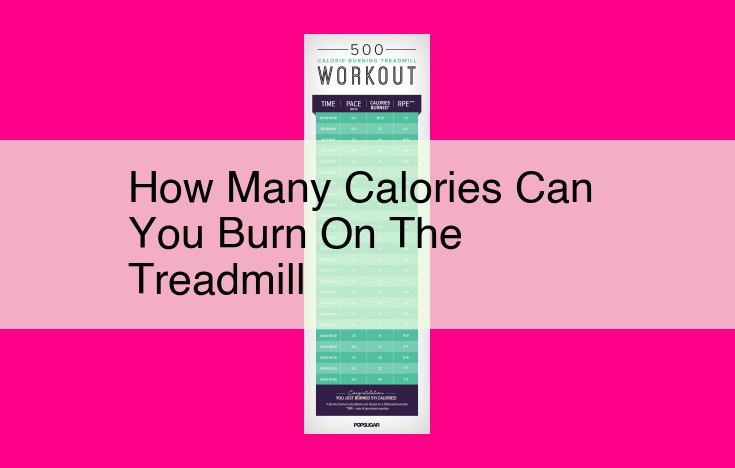Understanding Calorie Burn On A Treadmill: Factors And Impact

The number of calories burned on a treadmill depends on several factors, including speed, incline, duration, body weight, MET (Metabolic Equivalent of Task), calorie burn rate, age, gender, fitness level, and body composition. Treadmill speed and incline directly impact workout intensity and calorie expenditure. For example, running at 8 mph on a 5% incline burns more calories than walking at 4 mph on a flat surface. The duration of the workout also affects calorie burn, with longer sessions leading to higher calorie expenditure. Additionally, age, gender, fitness level, and body composition influence the rate of calorie burn, with younger, male, fitter individuals with higher muscle mass burning more calories during treadmill exercise.
A Comprehensive Guide to Treadmill Exercise: Factors to Consider
Embark on a fitness odyssey with our thorough guide to treadmill exercise. By delving into the intricate factors that shape your workout experience, you’ll optimize your time on the treadmill and unlock your fitness potential.
Treadmill Parameters: Your Workout’s Canvas
Treadmill Speed: The Pace that Dictates Intensity
Treadmill speed is the rhythmic heartbeat of your workout. As you increase the pace, your heart rate ascends, and the intensity of your exercise intensifies. This surge in intensity translates directly into a higher calorie burn, making treadmill speed a crucial factor in shaping the effectiveness of your workout.
Treadmill Incline: Elevate Your Challenge
Incline, the subtle slope of the treadmill, transforms your workout into a multifaceted challenge. As you ascend, the difficulty level escalates, engaging more muscle groups and amplifying the calorie burn. This incline-induced resistance not only enhances your fitness but also sculpts your physique by targeting specific muscle groups.
Exercise Duration: Time Well Spent
The duration of your treadmill workout is a dance between your fitness level and goals. For beginners, shorter sessions of 20-30 minutes are ideal, allowing for a gradual adaptation to the exercise. As your fitness blossoms, extend your workouts to 45-60 minutes or more to maximize calorie burn and endurance.
Body Weight: Your Energy Expenditure Meter
Your body weight plays a significant role in determining the energy you expend during treadmill exercise. A higher body weight necessitates greater exertion, leading to a higher calorie burn. This intrinsic relationship between weight and energy expenditure underscores the importance of considering your weight when gauging workout intensity.
Metabolic Variables in Treadmill Exercise: A Comprehensive Guide
Understanding the metabolic variables involved in treadmill exercise is crucial for maximizing workout efficiency and calorie burn. These variables include:
MET (Metabolic Equivalent of Task)
MET is a measure of exercise intensity, expressed as multiples of resting metabolic rate (RMR). The higher the MET value, the more calories you burn per minute. Treadmill speed and incline significantly impact MET values, with higher speeds and inclines leading to greater energy expenditure.
Calorie Burn Rate
The calorie burn rate during treadmill exercise is directly influenced by MET values. The faster you run or the steeper the incline, the more calories you burn per minute. Factors such as body weight, fitness level, and body composition also play a role in determining the calorie burn rate.
Total Calories Burned
Total calories burned over the duration of your treadmill workout depends on several factors, including:
- Exercise duration: The longer you exercise, the more calories you burn.
- Exercise intensity: Higher intensity workouts burn more calories per minute, resulting in a greater total calorie expenditure.
- MET values: Treadmill parameters such as speed and incline directly impact MET values, which in turn influence total calorie burn.
- Body weight: Heavier individuals burn more calories during treadmill exercise due to the increased mass they move.
Treadmill Exercise: Factors to Consider
Personal Factors:
Age plays a significant role in treadmill workouts. As we age, our fitness levels may decline, and our energy expenditure during exercise may decrease. This means that older adults may need to start at a lower intensity and gradually increase it over time.
Gender also influences treadmill exercise. Women typically have less muscle mass and a lower metabolic rate than men. This means that women may burn fewer calories during treadmill workouts than men, even when exercising at the same intensity.
Fitness level is an essential factor to consider when tailoring treadmill workouts. Beginners should start with shorter, lower-intensity workouts and gradually increase the duration and intensity as they get fitter. On the other hand, experienced exercisers can push themselves with longer, higher-intensity workouts to maximize calorie burn.
Body composition can also impact treadmill exercise effectiveness. Individuals with higher muscle mass burn more calories during workouts compared to those with a higher body fat percentage. This is because muscle tissue is more metabolically active than fat tissue. Therefore, incorporating strength training into your fitness routine can help increase your muscle mass and enhance calorie burn during treadmill workouts.
In conclusion, understanding the impact of personal factors on treadmill exercise is crucial for optimizing your workouts and achieving your fitness goals. By considering your age, gender, fitness level, and body composition, you can tailor your treadmill workouts to suit your individual needs and maximize their effectiveness.